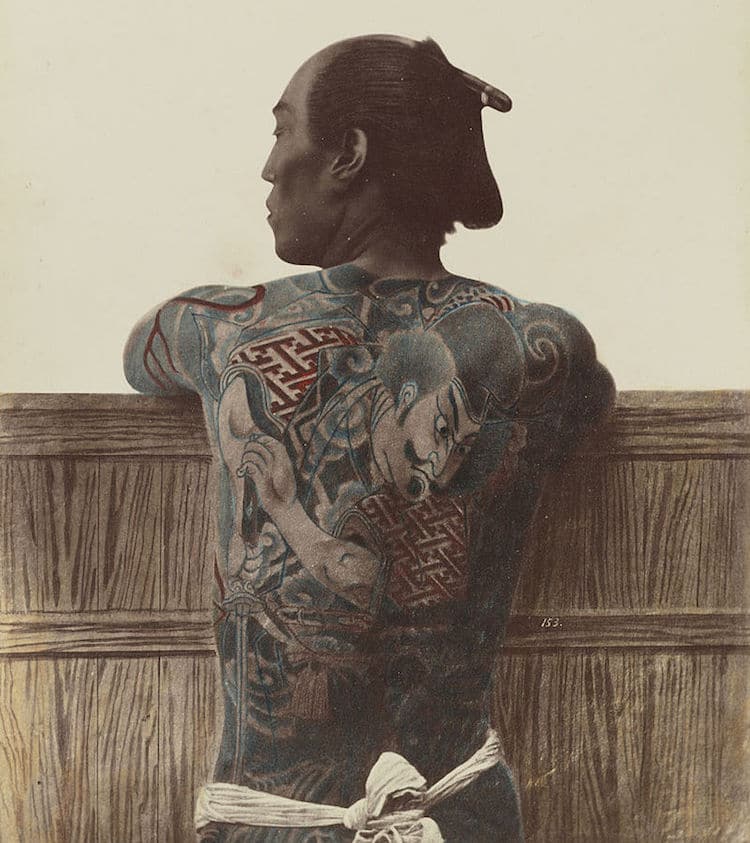Today, traditional Japanese motifs, designs, and stylistic sensibilities remain popular sources of inspiration behind many contemporary tattoos. Often, many ink artists opt to combine the old with the new to create pieces that range from playful prints to delicate works of art. Regardless of specific style, these Japanese-inspired tattoos have one thing in common: roots in Irezumi, or traditional Japanese tattooing. To gain an understanding and appreciation for this ancient art form, one must first learn about at its rich and colorful past.
Listen beautiful relax classics on our Youtube channel.
History
Like much of Japan’s art, tattooing can be traced back centuries.
The earliest indication of the body art phenomenon can be found on the seemingly tattooed faces of clay figurines from 5000 B.C. Another ancient mention of these markings is evident in Wei Chih, a Chinese chronicle from the 3rd Century. The telling text reveals that, at the time, “men young and old, all tattoo their faces and decorate their bodies with designs.” In the 7th Century, however, the art form took a turn. At this point, people began to view tattoos unfavorably. By 720 A.D., they were even used as a form of branding and punishment for prisoners, courtesans, and criminals. This practice would eventually last for over 1,000 years.

Figures with tattoo-like markings
In the 18th Century, Japanese tattoos underwent yet another transformation. Due to the prevalence of the colorful and pictorial woodblock print, tattoos rendered in this style became popular among groups of lower social status, like laborers, peasants, and even gangs. Given its ties to the lower class and its long and unsavory history, Irezumi was eventually outlawed in Japan—though artists based in the country could still legally tattoo foreigners.

Photo: Okinawa Soba

Photo: Rooksana Hossenally
This loophole proved particularly important in the 19th Century, when artists began tattooing nonnative sailors. As a result of this, their work—and all of the cultural motifs, symbols, and styles that accompanied it—was eventually “exhibited” all over the world. Thus, though still an illegal form of art for residents of its home country, the Japanese tattoo gained global prominence.

Photo: Horace Bristol
Major Motifs
In terms of subject matter, Japanese tattoos often showcase the culture’s reverence for nature—namely, animals and flowers. Additionally, much like the ukiyo-e prints that have inspired Japanese tattoos, figures and portraits are also frequently featured in traditional tattoos.
Animals
Many tattoos feature animals associated with strength, courage, and protection—like lions, tigers, and dragons. Koi fish are historically popular subjects, too, as they represent luck, success, and good fortune.

Photo: RattaTattoo
Flowers
Unsurprisingly, Sakura (or cherry blossoms) remain the most popular floral motif found in Japanese tattoos. Lotus flowers, peonies, and Chrysanthemums are also favored for their beauty and prevalence in Japan.

Photo: H2Ocean/a>
Figures
Both realistic and mythological figures are often featured in Japanese tattoos. Portraits of people rooted in realism include warriors and geishas, while folkloric figures include Tengu (ghosts) and Oni (demons or troll-like creatures).

Photo: RattaTattoo

Photo: RattaTattoo

Photo: RattaTattoo
Tattoos Today
Today, Japanese and non-Japanese tattoo artists alike often look to traditional Irezumi for inspiration. Though the practice has been legal in Japan since 1948, it is still somewhat taboo. Thus, finding a tattoo shop in the country can sometimes be challenging. Additionally, inked individuals are often prohibited from entering some public places, like bathhouses, hot springs, and gyms (though some of these spaces allow entry if the tattoos are concealed).
Listen beautiful relax classics on our Youtube channel.
Nevertheless, tattoos have proven popular among Japan’s younger generations. While many embrace contemporary tools like electric needles, some wish to preserve ancient approaches, like Tebori, or hand-tattooing. These pieces are created using a rod made of either metal or wood, and can take considerably longer to render than those made with more modern techniques. To many tattoo enthusiasts and artists, however, preserving the ancient craft is well worth the extra effort.
Below are some excellent examples of contemporary Japanese tattoos.

Photo: Next Luxury

Photo: electrictattooingviareggio

Photo: kaija_ink

Photo: _biggiemorlz_

Photo: jehle_tattoo

Photo: clareketontattoos

Photo: horiwaku

Photo: chuntattoo

Photo: lukacsarts

Photo: silvantattoo
Related Articles:
Japanese Woodblock Prints Reimagined as Quirky Contemporary Tattoos
Tattooist Fuses Contemporary Freehand Techniques with Traditional Japanese Themes
Cats Are Tattooing Other Cats in Surreal Japanese Ink Wash Paintings
The post Art History: Ancient Techniques and Evolution of Traditional Japanese Tattoos appeared first on My Modern Met.
Source: mymodernmet.com

